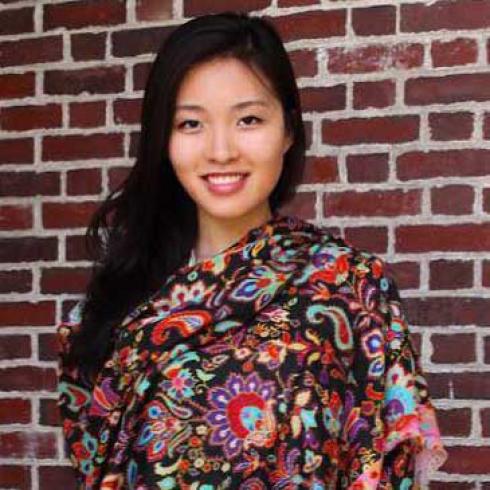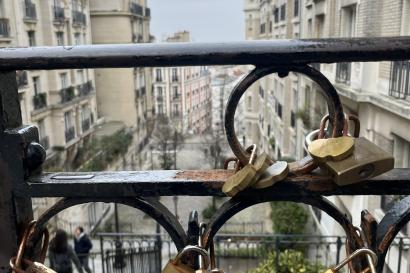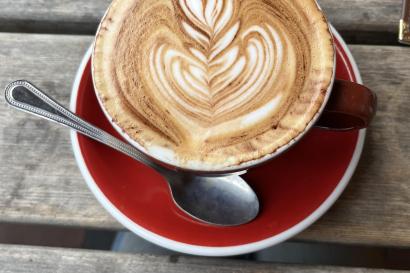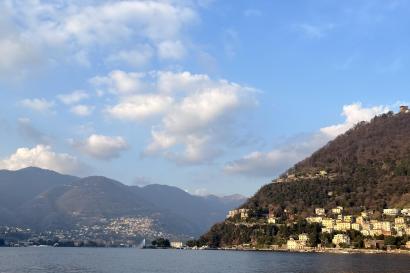Bonjour from Normandie!
Our program took a four hour bus ride northwest of Paris to Normandy. It was a fun trip because of the beautiful beaches and the wonderful food but the land was clouded by a sense of sadness from its war torn history. The beaches of Normandy were used as an entry point for the allied invasion on D-Day. It's shocking to think that World War II occurred less than a century ago. Normandy today is a quiet place, as opposed to the heavy commotion in 1944. Tag along for a quick tour of a region of France so different from Paris.
By the time we arrived, it was lunch time. Normandy is known for their heavy, creamy food. We had a goat cheese salad, duck drenched in barbecue sauce, ratatouille, and some cheesecake covered in red berries. It was wonderful and it was only the start of more more three course gourmet meals to come.
The museum also has a replica of a German bunker below the main museum. It was fascinating to be able to walk through the claustrophobic tunnel knowing that some people had to live there for an extended period of time. The weapon above was used to guard the entrance of the bunker.
Outside of the museum is the lovely statue of a US Navy sailor kissing a nurse after the announcement of Japan's surrender. It was a light note to a grim museum. One of the things I won't forget was all of the statistics from the war. The museum held many artifacts and ghastly stories, all strewn with numbers and facts. One statistic that haunts me is the fact that only 11% of Jewish children survived World War II.
We returned to the hotel with time to explore before dinner. Adriana and I took a walk along the beach. I believe our hotel lined Gold Beach, one of the five beaches used for D-Day.
The next morning, we had an early breakfast to start the day. A common French breakfast dish consists of bread dipped in half cooked boiled eggs (oeuf coque). Nathalie, our program director, gave us more insight on a normal French breakfast as we waited for our eggs to boil. I learned that the French children usually use bowls in the morning for their drinks or cereal. Children often have their own special bowl with their names, and sometimes even their birthdays, inscribed on them. Imagine our confusion when we only saw bowls next to the coffee/tea and orange juice pitchers. Nathalie also taught us that the cute Minnie Mouse patterned ceramics (above) holding the oeuf coque are called coquetier. You should put your oeuf coque in the coquetier and crack open just the top of your egg so that you can dip pieces of crunchy baguette in it. It tastes amazing. It's a must have in Paris and it's so easy to make at home.
We started our second day with a visit to the Musee du Debarquement, which focused on the Arromanches harbor. Countries including Britain, the United States and Canada couldn't just send soldiers to Normandy for the invasion. The soldiers needed food, supplies, etc. Winston Churchill brilliantly decided to build a port on Gold Beach so that ships could come to Normandie and transport equipment for the invasion. Thanks to Churchill's construction innovations and creative ideas such as fog and balloons to entangle enemy planes, the extensive port was built with incredible speed while the shores were under attack by the Germans. Through the windows of the museum, we could see the many sections of the port that remain today. These sections gave us an idea of how vast the port was in the 20th century.
"As our boat touched sand and the ramp went down I became a visitor to hell."
~Harry Parley, Private 116th Infantry Regiment
Nathalie pointed out a wall on one of the streets outside the museum. After the Paris attacks, and after learning about World War II, the painting expressed all our our thoughts.
On a lighter note, we had more good food at the hotel for lunch. Here's Adriana with three raspberry based vanilla ice cream chunks topped with chopped nuts.
As most of our program consists of American students, it was important that we visit the American cemetery at Colleville. We were all so proud to be American after learning about how America helped in ending World War II. This cemetery land was given to the US by France. It was surreal to stand on US soil after being in Europe for so long. The cemetery looks as if it never ends. There are hundreds of rows of crosses, each marking another death. It was really moving to learn that all of the graves face towards the US, home.
IES Abroad Paris BIA has a tradition of leaving flowers for Monsieur Quinones. A couple of years ago, one of the students in the program went on the Normandy trip and told one of the program advisors, Nathalie perhaps, that his grandfather's brother fought in WWII and was buried in Normandy. His family had always wanted to visit but it just never worked out. During his field trip, one of our advisors called the American cemetery prior to their visit to see if Monsieur Quinones was buried there but they said no. The student was obviously upset but he didn't show it. When they arrived at the memorial, the workers at the visitor's center noticed the program group and got excited. They had, in fact, found the boy's great-uncle. They gave him the row number and he went with the advisors to find the gravestone. He took a picture there and expressed his gratitude to the program advisors for helping him visit his relative. He had promised his grandmother that he would get a picture with the grave since she couldn't visit herself. She, at the time, was already in her late 90's. Ever since then, the program has left flowers at the student's great-uncle's grave at every Normandy field trip. This program is remarkable for being able to build such strong, lasting ties between their American students and France.
The Normandy field trip was an incredible addition to our experience in Paris. Thank you to all the program advisors for making the trip possible. Merci beaucoup to all veterans.
À la prochaine,
Gwen

Gwen Lee
<p>Salut! Je m'appelle Gwen. I am a sophomore at Babson College and currently about 11% fluent in French. I hope to remedy that while wining and dining in the beautiful city of Paris. I am majoring in Business with a focus in Marketing. Follow along my stories to experience the ups and downs of studying abroad à Paris!</p>







